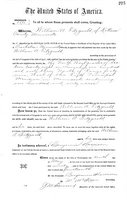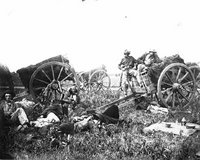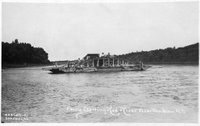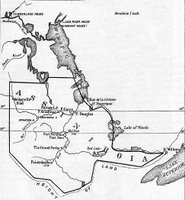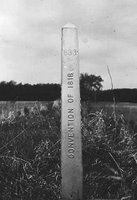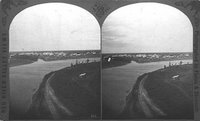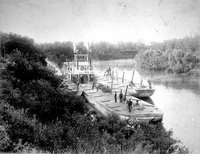1775-1783 - American Revolution 1783 - The newly formed republic of the United States of America wins the eastern portion of Minnesota (from the Mississippi river east) from Great Britain in the American Revolution.
1787 - Eastern Minnesota officially designated part of the American Northwest Territories of the United States of America. David Thompson, working for the North West Company (fur-trading) completes the first formal mapping of Minnesota.
19th Century
1800 - France acquires Louisiana Territory from Spain.
1803 - The United States of America purchases Louisiana Territory from France, gaining ownership of the western portion of Minnesota. Boundary disputes with British Canada keep British fur companies in Minnesota until 1818.
1805 - Lieutenant Zebulon Montgomery Pike leads the first United States expedition through the Minnesota country.
1812-1814 - War of 1812 between the United States and Great Britain with their Dakota, Winnebago, and Ojibwe allies.
1815 - Peace treaty negotiated between the Dakota Indian nation and the United States government. First American fur traders enter Minnesota.
1818 - Northern boundary of Minnesota fixed at the forty-ninth parallel. Boundary negotiations with British Canada continue until 1931. Lawrence Taliaferro instated as first United States Indian agent at Fort Snelling.
1819 - Colonel Josiah Snelling begins construction of Fort St. Anthony on land purchased from the Dakota Indians for $2000 US.
1824 - Fort St. Anthony completed. Name changed to Fort Snelling in Honor of Colonel Josiah Snelling's work.
1832 - Henry Schoolcraft credited with finding the source of the Mississippi River at Lake Itasca, Minnesota with his Ojibwe guide Ozawindib.
1836 - Creation of Wisconsin Territory which encompassed Minnesota.
1837 - Land-cession treaties negotiated with the Dakota Indians and the Chippewa Indians for United States rights to a portion of land between the Mississippi and St. Croix rivers. This new land stimulates the lumber industry in Minnesota.
1841 - Chapel of Saint Paul built. Later it would serve to name the state capitol which sprang up around it.
1838-1848 - St. Paul, St. Anthony, and Stillwater (Minnesota's first towns*) founded.
*NOTE: I take exception to this - St.Vincent, although not an 'official' town at this time, is part of the trading posts/forts around Red/Pembina Rivers and has been for many years before this time...most acknowledge that our area is one of the oldest settlements in the upper midwest...
1848 - Wisconsin admitted into the union as a state, leaving residents of the area between the Mississippi and St. Croix rivers (current day eastern Minnesota) without a territorial government or legal system.
1849 - Minnesota Territory formed with present day eastern and southern boundaries set. The population amounts to less than 4000 people, not including persons of pure Native-American heritage. Law provides for free public schools to be open to all people between four and twenty-one years of age. Minnesota Historical Society formed to collect, publish, and educate people about Minnesota history. James Madison Goodhue begins publishing Minnesota's first newspaper, the Minnesota Pioneer.
1850 - Treaties concluded at Traverse des Sioux and Mendota with the Dakota Indians whereby the Dakota ceded their lands east of the Red River, Lake Traverse, and the Big Dakota River and south of a boundary line between the Dakota and Chippewa in 1825. In return the Dakota received $1,665,000 US, $1,360,000 of which was set into a trust fund, of which the interest would be distributed to chiefs partly in cash, partly in supplies, and partly in education and civilization funds. The vast majority ended up being used to pay off Indian debts to white traders. Wheat becomes a major crop in Minnesota.
1851 - Charter granted to the University of Minnesota, the first collegiate institution in the territory.
1853-1857- Population explosion occurs in Minnesota from 40,000 people in 1853 to approximately 150,000 people in 1857.
1854 - St. Paul becomes a city with a total area of four square miles.
1855 - Die Minnesota Deutsche Zeitung (The Minnesota German Newspaper), Minnesota's first non-English newspaper, rolls off the press for the first time in St. Paul.
1857 - The Dred Scott Decision is rendered by the United States Supreme Court, where a Missouri slave, Dred Scott, sued for his freedom based in part upon his residence in Minnesota. Amidst the sectional and racial animosity sweeping the nation, the court ruled Scott remained a slave. The residents of the Minnesota territory ratify the state constitution almost unanimously. The Panic of 1857 sends prices skyrocketing. Banks bust and businesses fail. Depression lingers until 1861.
1858 - Newspaper promotion of the Minnesota Territory prompts over one thousand steamboat arrivals in St. Paul, filled with settlers. On May 11 Minnesota becomes the thirty-second state admitted to the Union of the United States of America. State seal adopted by the Minnesota Legislature.
1858-1859 - Henry Sibley instated as first governor of Minnesota.
1859 - First Minnesota State Fair held.
1861 - Civil War of the United States begins. Minnesota volunteers one thousand men for service in the Union Army. Minnesota eventually provides 24,000 men for service in the Union Army for fighting in the Civil War or the Indian Outbreak.
1862 - The Dakota Conflict sweeps across Minnesota with a series of attacks motivated by hungry Dakota enraged by the failure of land treaties and unfair fiscal
practices of local traders. By the end of the conflict 486 white settlers would be dead. On December 26 thirty-eight Indians were hung at Mankato. Minnesota's first railroad is completed, connecting Minneapolis and Saint Paul.
1863 - At the Battle of Gettysburg the First Minnesota Regiment makes a heroic charges, losing 215 of 262 men.
1865 - Civil War of the United States ends.
1868 - Mankato receives a city charter. The Minnesota Legislature authorizes establishment of the 2nd State Normal School in Mankato (now known as Minnesota
State University, Mankato). 1873 -A three-day blizzard hits Minnesota in January, killing seventy Minnesotans.
1878 - 68.98% of tilled land in Minnesota devoted to wheat production, the high point for wheat farmers in Minnesota. After five consecutive summers of devastating infestations of Rocky Mountain Locusts (called the great Grasshopper Plague) which thrived on wheat, farmers decided to diversify, and wheat production was slowly replaced by other crops and dairy farming. A massive explosion in a Minneapolis flour mill kills 18.
1880 - Telephone communication begun between St. Paul and Minneapolis.
1881 - St. Paul is destroyed by fire.
1883 - Mayo Clinic founded by Dr. William Worrall Mayo in Rochester, Minnesota after a tornado sweeps through Rochester, killing 35. With his two sons, Dr. William
James Mayo and Dr. Charles Horace Mayo, he begins a clinic world-renowned for
its dedication to the latest advances in medicine and surgical procedures.
1884 - Minnesota iron ore begins to be exported heralding the dawn of iron mining in Minnesota. Over the next two decades mines spring up on the Mesabi, Cuyuna, and Vermilion iron ranges, spurring the rapid growth of mining cities such as Evelyth, Chisholm, Virginia, and Hibbing, Minnesota as well as the port cities of Duluth, Minnesota and Superior, Wisconsin.
1886 - Sauk Rapids is flattened by a tornado. Seventy-nine people die. St. Paul holds its first winter carnival.
1887 - St. Paul hosts the first ski tourney in the Midwest.
1888 - Western Minnesota receives a major blizzard on January 12 which takes 109 lives.
1890s - Electric streetcars become commonplace in large Minnesota cities.
1893 - The Minnesota state flag, designed by Amelia Hyde Center of Minneapolis, is accepted by the Minnesota Legislature. Virginia, Minnesota destroyed by fire.
1894 - A massive forest fire caused by clear-cut logging debris encompasses Hinckley, Minnesota and several other nearby communities. Over four hundred die.
1898 - The Spanish-American War begins. Minnesota, the first state to volunteer, raises four regiments, one of which serves in the Philippines. Disease proves to be the biggest killer, with combat fatalities accounting for only four Minnesota soldier deaths. Farmer Olof Ohman finds a stone tablet with runic carvings on it in his field near Kensington, Minnesota. The runes indicate a party of Viking explorers passed through that area in 1362. Initially considered a hoax, it was accepted by the Smithsonian Institution in 1948. Opinions differ, but most academic sources today doubt its veracity.
1899 - Minnesota's lumber industry reaches its peak. By 1930 only 1/3 of the state would remain forested, with very little of that virgin growth.
20th Century
1900 - Virginia, Minnesota destroyed by fire again.
1902 - Approximately twelve automobiles appear in Minneapolis. Tom Shevlin, son of a lumber magnate, gets arrested for violating the ten mile per hour city speed limit.
1905 - John A. Johnson, Minnesota's first native-born governor, elected to the first of his three terms. Lumber production peaks in Minnesota.
1906 - William Williams is hanged in the county jail in St. Paul on February 13, ending capital punishment in Minnesota.
1908 - Chisholm, Minnesota is virtually obliterated by a late summer forest fire.
1914 - World War I begins. Minneapolis becomes the home of the Federal Reserve Bank.
1917 - The United States of America enters World War I. 118,497 men from Minnesota serve in the war.
1918 - World War I ends with 1,432 Minnesotans in uniform giving their lives for their country. The new Farmer-Labor Party becomes the second largest political party in Minnesota and capitalizes on the rural depression which plagues Minnesota until 1824 to gain a broad base of support. Influenza spreads to Minnesota. Labeled a "pandemic of influenza", this disease managed to kill 7,521Minnesotans in 1918 and more than 4,200 over the course of the following two years. Cloquet and Moose Lake, Minnesota are destroyed when seventy mile an hour winds change minor forest fires into major conflagrations.
1919 - Minnesota ratifies the 19th amendment (women's suffrage) to the United States constitution. A tornado strikes Fergus Falls, Minnesota killing 59.
1920 - Minnesota authors receive international recognition. Main Street, written by Sinclair Lewis, earns national recognition as he takes a critical look at his hometown of Sauk Centre, Minnesota. By the end of the decade he had won the Nobel Prize for literature after a string of four more novels won international acclaim. St. Paul native F. Scott Fitzgerald receives much acclaim for his book This Side of Paradise. By 1925 he had published five more works, all focusing on the extravagance and despair of the 1920s in the United States.
1921 - WLB, the first Minnesota radio station, formed at the University of Minnesota.
1927 - Charles Lindbergh, a native of Little Falls, Minnesota, flies solo across the
Atlantic Ocean from New York to Paris.
1929 - Great Depression begins in the United States. The depression begins in Minnesota with the bankruptcy of key employers in Minneapolis and quickly spreads to the rest of the state.
1930-1935 - Over 1/2 of iron ore extracted from the earth originates in Minnesota mines.
1931 - Ancient remains of 20,000 year old skeleton dubbed "Minnesota Man" found in Otter Tail County, Minnesota.
1933 - "Browns Valley Man" remains, estimated to be 8,000 - 10,000 years old, discovered in Brown County, Minnesota.
1934 - Edward G. Bremer of St. Paul kidnapped by the Barker-Karpis gang. His ransom of $200,000 US is one of the largest ransoms in the United States up to that time. By 1936 the kidnappers had been caught and convicted. "Public Enemy Number 1" John Dillinger has a gun battle with FBI agents in St. Paul on March 11 and escapes.
1936 - Temperatures remain below zero for a record thirty-six days beginning on January 18. Later in the summer Moorhead, Minnesota ties a state record high official temperature of 114 degrees Fahrenheit, previously set in Beardsley, Minnesota in 1927.
1939 - A hockey game in the Duluth Amphitheater is interrupted when the ceiling collapses under the weight of snow. No deaths are reported.
1940 - The Armistice Day Blizzard strikes Minnesota leaving a 16.8 inches of snow in twenty four hours. Winds that day exceed thirty two miles per hour with gusts over sixty miles per hour. Forty-nine Minnesota residents die and over $1,500,000 US worth of property is damaged as a result of the storm.
1941 - First tax on taconite, a black magnetic iron-bearing ore, in effect in Minnesota. The United States enters World War II. Singer Bob Zimmerman
(Bob Dylan) born in Duluth.
1944 -The Democratic and Farmer Labor parties merge to form the Democratic-Farmer-Labor Party.
1945 - World War II ends with 6,255 American servicemen from Minnesota giving their lives for their country. The Minnesota state song, "Hail! Minnesota" is adopted by the Minnesota Legislature.
1948 - Minnesota's first television station, KSTP, goes on the air.
1950 - The Korean War begins. By the time of the armistice in 1953, 688 Minnesotans had died in the fighting.
1951 - Over 82% of iron ore extracted from United States mines during this year originates in Minnesota.
1954 - Coya Knutson becomes the first Minnesota woman elected to the Congress of the United States.
1958 - Prince Rogers Nelson (the artist formerly known as Prince) born in Minneapolis.
1959 - The opening of the St. Lawrence Seaway makes Duluth accessible to the Atlantic Ocean.
1963 - Last iron ore shipment leaves the Vermillion iron range.
1964 -Minnesota Senator Hubert Humphrey elected vice-president of the United
States as the running-mate of president Lyndon Johnson. Conventional American ground forces are introduced into Vietnam.
1968 - Senator Eugene McCarthy of Minnesota begins his bid for the presidency by easily winning the New Hampshire presidential primary. Minnesota Senator Hubert Humphrey also runs for president that year, narrowly losing to Richard Nixon. The American Indian Movement (AIM) is founded in Minneapolis to combat racism.
1969 - Warren Burger, a native of St. Paul, named to the Supreme Court of the United States.
1970 - Minnesotan Harry Blackmun named to the Supreme Court of the United States. He would later write the majority opinion in the case of Roe v. Wade, which legalizes abortion.
1975 - The last American military personnel leave Vietnam with the evacuation of the United States embassy in Saigon, completely ending American involvement in Vietnam and the Vietnam War. 1,053 Minnesotans gave their lives over the course of the war.
1976 - Jimmy Carter becomes the 39th president of the United States with Minnesota Senator Walter Mondale as his vice-president. Mondale would later run for president in 1984, losing to Ronald Reagan.
1977 - Rosalie Wahl becomes the first woman justice in the Minnesota Supreme Court.
1980 - Last iron ore shipment leaves the Cuyuna iron range.
1982 - A total of 34.3 inches of snow falls on the Twin Cities on January 20 and 22. Taconite mining emerges as the future employment source for the iron range, with 12,000 workers. The subsequent depression and trend toward mechanization halve that number by 1995.
1984 - Last iron ore shipment leaves the Mesabi iron range, effectively ending Minnesota's direct iron ore industry and confirming a difficult depression on the iron range.
1987 -The Minnesota Twins win the World Series.
1988 - The Indian Gaming Regulatory Act, passed to promote tribal economies, causes a boom in Indian casinos and gambling in Minnesota. By 1990 Minnesota ranks fourth in the nation in per capita gambling sales. Minnesota hit by a record setting drought.
1990 - Soviet President Mikhail Gorbachev visits Minnesota.
1991 - Operation Desert Storm occurs with approximately 11,000 Minnesotans in uniform helping to defeat Iraq and liberate Kuwait. The Minnesota Twins win the World Series. A record-breaking snowstorm hits Minnesota on November 1 depositing twenty-four inches of snow in twenty-four hours.
1996 - Coldest official temperature ever recorded in Minnesota set at -60 degrees Fahrenheit on February 2 near Tower, MN.
1998 - Minnesota becomes home to largest ethnic Hmong population in America.
